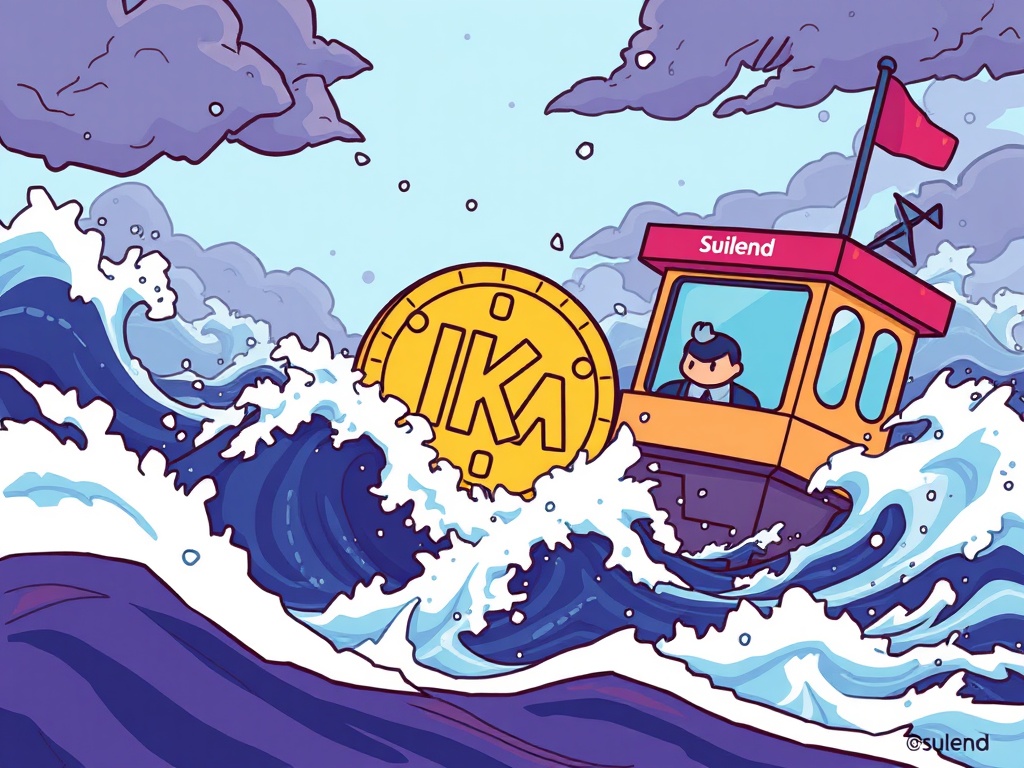Suilend IKA Lending: Urgent Suspension Amidst Extreme Volatility
BitcoinWorld
Suilend IKA Lending: Urgent Suspension Amidst Extreme Volatility
The world of decentralized finance (DeFi) is often lauded for its innovation, but it also comes with inherent risks. Recently, a significant event unfolded that highlights these challenges: the Suilend IKA lending services suspension. Suilend, a prominent crypto lending platform built on the Sui blockchain, has made the difficult decision to halt all lending services for its IKA token. This move comes in response to extreme price volatility that caused substantial losses for its users, sending ripples through the DeFi community.
What Triggered the Suilend IKA Lending Suspension?
Understanding the root cause of this drastic measure is crucial for anyone involved in crypto lending. The immediate trigger was an unprecedented surge in the IKA token’s price. Early this morning, the token’s value skyrocketed from a modest $0.04 to an astonishing $0.47.
While a price increase might sound positive, such rapid and extreme fluctuations can be incredibly destabilizing for lending protocols. This sudden spike led to a critical situation where several user positions were liquidated at abnormally high prices. The consequences were severe: a collective loss of $379,000.
These losses were not absorbed by the platform itself, but unfortunately, by users who had deposited IKA tokens into the protocol. This directly resulted in a 6% reduction across all IKA deposits on the platform, a stark reminder of the inherent risks associated with high-volatility assets in lending pools. The platform acted swiftly to prevent further damage by implementing the Suilend IKA lending suspension.
The Dire Consequences of IKA Token Volatility
When a token experiences such wild swings, the entire ecosystem built around it can be jeopardized. For users of Suilend, the impact was immediate and painful.
- Unexpected Liquidations: Positions were liquidated at inflated prices, meaning users lost more collateral than they would have under normal market conditions.
- Reduced Deposits: The 6% reduction in IKA deposits reflects a direct loss for those who trusted the platform with their assets.
- Erosion of Trust: Incidents like these can shake user confidence in DeFi platforms and the broader crypto lending space.
The decision to suspend Suilend IKA lending was a necessary step to protect remaining user funds and stabilize the protocol. It underscores the critical need for robust risk management strategies in decentralized finance, especially when dealing with newer or less liquid tokens. How do platforms balance innovation with user safety?
Safeguarding Your Assets: Lessons from Suilend IKA Lending
This incident serves as a powerful cautionary tale for both platforms and individual investors. For platforms like Suilend, it highlights the importance of:
- Dynamic Risk Parameters: Implementing systems that can quickly adjust collateral ratios, liquidation thresholds, and even suspend services in extreme market conditions.
- Robust Oracles: Ensuring price feeds are resilient against manipulation and accurately reflect true market value, even during flash crashes or pumps.
- Transparency: Clearly communicating risks and actions taken to users.
For users engaging in crypto lending, consider these actionable insights:
- Diversify: Don’t put all your assets into a single token or platform.
- Understand the Risks: Always research the underlying token’s volatility and the platform’s risk management policies.
- Monitor Positions: Keep a close eye on your lending positions, especially with volatile assets.
The proactive measure of the Suilend IKA lending suspension, while painful, aims to prevent a larger catastrophe.
The suspension of Suilend IKA lending services due to extreme volatility is a stark reminder of the unpredictable nature of the crypto market. While such events are challenging, they also drive innovation in risk management and highlight the importance of user education. As the DeFi space continues to evolve, platforms and users alike must prioritize vigilance and adapt to safeguard assets against unforeseen market forces. This incident will undoubtedly prompt further discussions on how to build more resilient and user-protective lending protocols.
Frequently Asked Questions (FAQs)
1. What is Suilend and why did it suspend IKA lending?
Suilend is a crypto lending platform operating on the Sui blockchain. It suspended IKA lending services due to extreme price volatility of the IKA token, which led to significant user losses and liquidations.
2. What caused the extreme volatility of the IKA token?
The IKA token experienced an sudden and rapid price surge, skyrocketing from $0.04 to $0.47 in a short period. This extreme fluctuation destabilized the lending protocol.
3. How were Suilend users affected by the IKA lending suspension?
Users faced liquidations at abnormally high prices, resulting in a collective loss of $379,000. This also led to a 6% reduction in all IKA deposits on the platform.
4. What measures can crypto lending platforms take to prevent similar incidents?
Platforms can implement dynamic risk parameters, ensure robust and resilient price oracles, and maintain transparency with users regarding risks and actions taken during market stress.
5. What should users do to protect their assets in DeFi lending?
Users should diversify their investments, thoroughly understand the risks associated with volatile tokens and platforms, and actively monitor their lending positions.
If you found this analysis of the Suilend IKA lending suspension informative, please consider sharing it with your network on social media. Your insights and awareness help strengthen the entire crypto community.
To learn more about the latest crypto lending trends, explore our article on key developments shaping decentralized finance risk management.
This post Suilend IKA Lending: Urgent Suspension Amidst Extreme Volatility first appeared on BitcoinWorld and is written by Editorial Team
You May Also Like

Buterin pushes Layer 2 interoperability as cornerstone of Ethereum’s future

Eric Trump bets Fed rate cut will send crypto stocks skyrocketing
